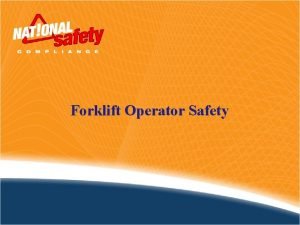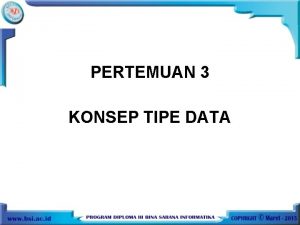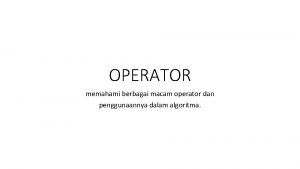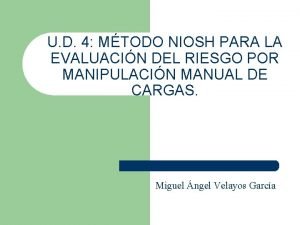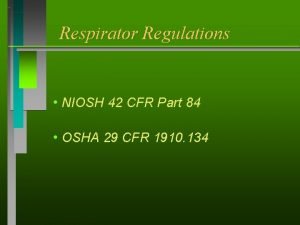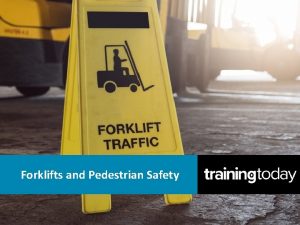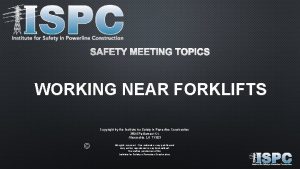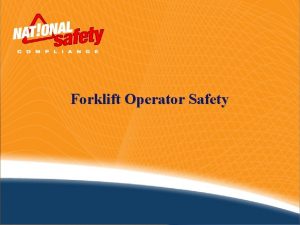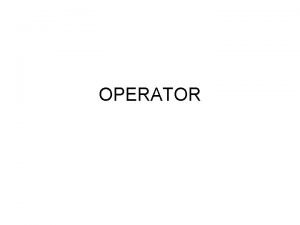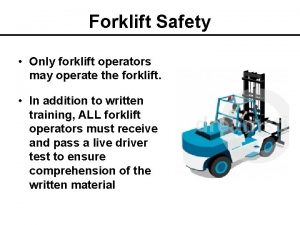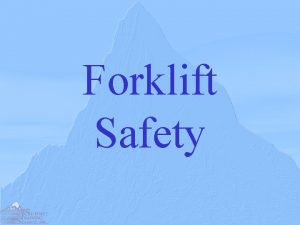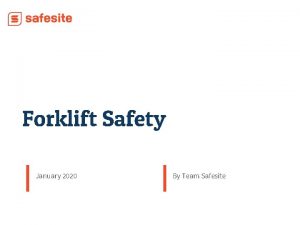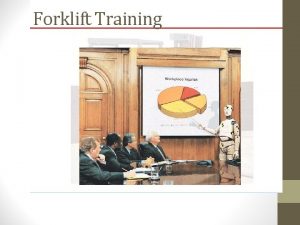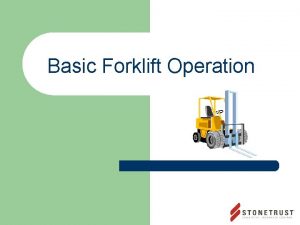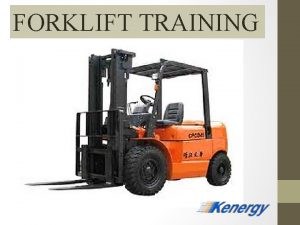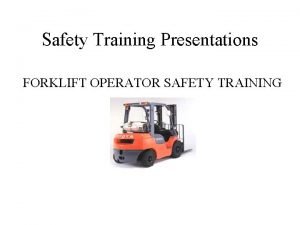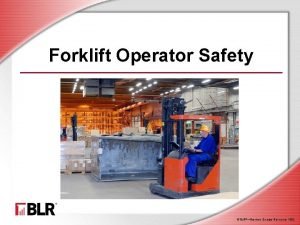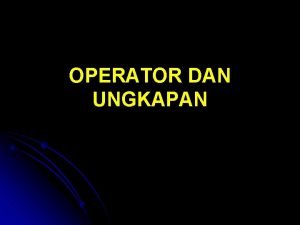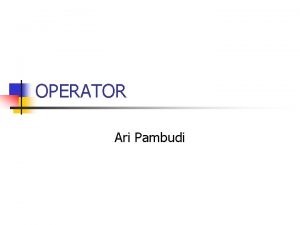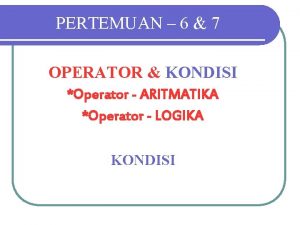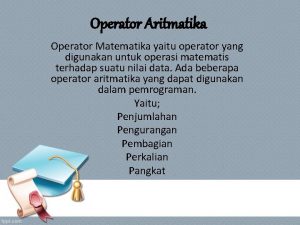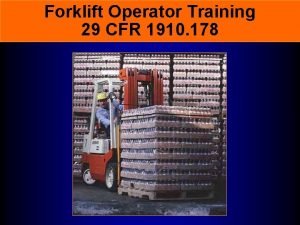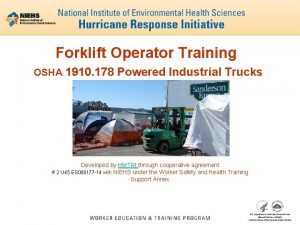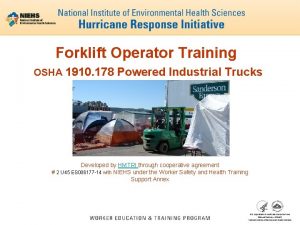Forklift Operator Safety The Importance of Safety NIOSH



























- Slides: 27

Forklift Operator Safety

The Importance of Safety NIOSH calculates that approximately 100 deaths and 20, 000 injuries occur annually in the U. S. due to forklifts. The costs incurred by forklift related accidents are estimated to be over $100, 000. 20% of forklift incidents involve a forklift striking a pedestrian.

The Importance of Safety A powered industrial truck is any vehicle, such as lift truck, fork truck, motorized hand truck or any other specialized industrial truck, that is powered by electric motors or internal combustion engines. (29 CFR 1910. 178 does not apply to compressed air or non-flammable compressed gas operated trucks. )

Training OSHA requires all potential forklift operators to attend forklift training before operating equipment. The training must cover: - Truck related topics - Workplace related topics - The requirements of the 29 CFR 1910. 178 Standard

Training Truck related topics include, but are not limited to: - Operating instructions, warnings and precautions - Differences between the truck and the automobile - Truck controls and instrumentation - Engine or motor operation - Operating limitations - Vehicle capacity and stability - Vehicle inspections and maintenance - Refueling or recharging of batteries - Steering and maneuvering - Visibility (including restrictions) - Fork and attachment adaptation, operation, and use limitations

Training Workplace related topics include, but are not limited to: - Surface conditions - Hazardous locations - Composition of loads being carried - Ramps and other sloped surfaces - Load manipulation, stacking and un-stacking - Pedestrian traffic in areas to be operated - Closed environments and other areas of insufficient ventilation - Other Unique or potentially hazardous environmental conditions in the work place. - Narrow aisles and other restricted areas

Refresher Training Refresher training must be provided when: - The operator has been observed to operate the vehicle in an unsafe manner, - The operator has been involved in an accident or near-miss incident, - The operator is assigned to drive a different truck, or - A condition in the workplace changes in a manner that could affect safe operation of the truck. - At least every three years.

Types and Characteristics of Forklifts Powered industrial trucks are divided into seven classes. Class I – Electric motor rider trucks Class II – Electric motor narrow aisle trucks Class III – Electric motor hand trucks or hand/rider trucks Class IV – Internal combustion engine trucks (Solid/Cushion Tires) Class V – Internal combustion engine trucks (Pneumatic tires) Class VI – Electric and internal combustion engine tractors Class VII – Rough terrain forklift trucks

Types and Characteristics of Forklifts Class I – Electric motor rider trucks The weight of these trucks usually counterbalance the weight that is carried on the forks with the front axle as the fulcrum. This type of truck is often used indoors because it does not emit exhaust Stand up Sit down

Types and Characteristics of Forklifts Class II – Electric motor narrow aisle trucks The weight of the load is often more spread out and does not use an axle as a fulcrum. The operator must wear a harness for fall protection if the platform must be elevated with the forks such as the order picker or turret trucks.

Types and Characteristics of Forklifts Class III – Electric motor hand/rider trucks These trucks are used for transporting pallets. They generally do not lift the load very high off the ground. Some can be ridden while others must be walked beside. Walk Beside Ride on

Types and Characteristics of Forklifts Class IV – Internal combustion engine trucks (Solid/Cushion Tires) Class IV trucks use a tank of combustible gas such as LPG to power the truck. The tires on the Class IV trucks are solid rubber or are filled with foam to prevent punctures. Sit Down Rider – Gas – Solid Tires

Types and Characteristics of Forklifts Class V – Internal combustion engine trucks (Pneumatic Tires) Class V trucks use a tank of combustible gas such as LPG to power the truck. The tires on the Class V trucks are reinforced and filled with air.

Types and Characteristics of Forklifts Class VI – Electric and internal combustion engine tractors These tractors are commonly seen in salvage yards or to tow large planes. They are designed to push, pull or carry very large loads.

Types and Characteristics of Forklifts Class VII – Rough terrain trucks The Straight-mast forklift has more stability while transporting materials Rough terrain trucks are most useful in construction to lift and transport loads on the job site. Each has its advantages. The Extended-reach forklift can raise loads to elevated areas or across trenches.

Pre-Operation Inspections should be performed at the beginning of each shift. Follow an inspection check list that is provided by the employer. The list should contain: - lights - carriage - horn - tires - brakes - fluid levels - back up alarms - steering - seat belts - overhead guard - mast - back rest - chains Always inspect the items that do not require the engine to be running first then check all other components. Check the forklift by maneuvering it through normal positions and ensure that it does not hesitate or delay.

Basic Driving Safety - Seat belts must be worn at all times while driving a powered industrial truck. - Keep all body parts in the operator's cabin at all times. - Only operate trucks in designated safe areas. Make sure the surface is clean and free of spills or debris. - Be alert to the surroundings. Watch for obstructions, low hanging items, lights, sprinkler heads or pedestrians. - Never go too fast. Forklifts should never be driven faster than allows for a safe stopping distance. - Slow down and sound horn at all intersections - Never follow another truck closer than 3 truck lengths. - Never allow riders any where on the vehicle. - Always travel with the load as close as safely possible to the ground. - Always cross tracks or other bumps in the path at an angle to maintain two wheels on the ground.

Stability Triangle - Figure 1 1. When the vehicle is loaded, the combined center of gravity (CG) shifts toward line B-C. Theoretically the maximum load will result in the CG at the line B-C. In actual practice, the combined CG should never be at line B-C. 2. The addition of additional counterweight will cause the truck CG to shift toward point A and result in a truck that is less stable laterally. B Vehicle Center of Gravity (Unloaded) A C Center of Gravity of Vehicle and Maximum Load (Theoretical)

Stability Triangle - Figure 2

Stability 3. Each load has its own “load center. ” This is the distance from the mast to the center of the load’s weight mass. This distance greatly affects the load capacity of forklifts. The nameplate will state the “load center” measurement upon which the capacity is based. In most cases this is 24 inches. That means that the “load center” should be no further than 24 inches away from the mast of the forklift. If the load center is further away, then the load capacity will diminish. Tilting the mast forward also changes the stability triangle. The mast should never be tilted forward when raised, unless it is over a rack or other supporting object. § § Forklifts can also tip over without a load. When forklifts are moving without a load, the center of gravity is near the rear of the vehicle and very close to the side of the stability triangle. At this point any quick turn or even unstable driving surface could cause the forklift to tip over. Another aspect of the stability triangle is the vertical stability or the line of action. This is a vertical line that runs through the forklift’s center of gravity. If the line of action shifts outside the stability triangle, the forklift will tip over. The placement of the load on the forks, how high the load is raised, the angle of the floor underneath the forklift and momentum are all factors in keeping the line of action within the stability triangle. § If your forklift begins to tip, do not jump. You could be crushed beneath the forklift or load. Brace yourself, hold onto the steering wheel and pull yourself tight up to it. Keep all parts of your body inside the operator area.

Transporting Loads - Inspect loads to ensure that they are properly secure, won't shift during travel and that the load is not too heavy for the lift. - When approaching the load, adjust forks as wide as possible and position them at the correct level before picking up the load. - Drive forward till the load rests against the mast and level the forks. - Lift the load high enough to clear the floor or rack and then tilt the mast back slightly. - Once clear from obstruction, lower the mast to a few inches off the ground to clear any obstacles while traveling. - If the load is too tall and obstructs your view, drive backwards or have a spotter.

Ramps Always inspect the surfaces the lift will be traveling on. Make sure that any ramps or trailer floor surfaces can support the weight. Never drive across a slope at an angle because the lift could tip over. Before entering a trailer, rail car or truck, make sure the brakes are set on the trailer, the wheels are blocked and are properly supported so that they don't tip while you are driving in them. Always approach ramps with the load facing up hill. If the load is facing downward, there is a good chance that it will be lost.

Parking If the operator leaves the vehicle out of sight or is farther than 25 feet the lift should be shut off. - Place transmission in neutral - Apply the parking brake - Lower the forks to the ground - Do not block paths or fire fighting equipment - Block wheels if on a slope.

Fuel and Batteries Battery powered trucks - Make sure battery connections are tight before operating. - Test the battery's electrolyte level (remember to use Personal Protective Equipment). - Battery charging should only be done in designated “No smoking” areas. The charging produces flammable hydrogen gas. - Don't turn the charger on till the battery is connected. - Make sure the battery is secured in the compartment. Batteries that move may cause the lift to overturn.

Fuel and Batteries Combustion fuel trucks - Check the emissions annually on all combustible fuel trucks. - Only refuel in designated “No Smoking” areas. - Remove propane tanks prior to refilling. When replacing the tank, ensure the tank location pin is properly aligned before securing the tank.

Attachments - Some forklifts can use platforms to raise and lower personnel. These platforms are the only approved method for raising anyone standing or sitting on the forks. Fall protection devices must be used. - There are many other attachments that can be used. Each attachment must have a plate stating the weight capacity. Remember that these attachments can change the load center of gravity and then diminish the load capacity.

Conclusion - Operators must complete a training course before operating any powered industrial truck. - Always wear a seat belt while operating a powered industrial truck. - Approach tracks or any bumps in the road at an angle to maintain at least 2 wheels on the ground. - Turn off trucks anytime that you are more than 25 feet away or out of sight of the truck. - Attachments can change the center of gravity and cause a truck to tip over more easily.
 Forklift training niosh
Forklift training niosh Pada tipe data boolean berlaku operator-operator
Pada tipe data boolean berlaku operator-operator Pada tipe data boolean, berlaku operator-operator...
Pada tipe data boolean, berlaku operator-operator... Logical operators priority in c
Logical operators priority in c Unary and binary operators
Unary and binary operators Niosh penang
Niosh penang Elle kaldırma ve taşıma işlerinde temel prensipler
Elle kaldırma ve taşıma işlerinde temel prensipler Metodo niosh
Metodo niosh Multiplicador de asimetria
Multiplicador de asimetria Nioshh
Nioshh Niosh oeb
Niosh oeb Forklift/pedestrian safety powerpoint
Forklift/pedestrian safety powerpoint Forklift safety meeting topics
Forklift safety meeting topics Hát kết hợp bộ gõ cơ thể
Hát kết hợp bộ gõ cơ thể Slidetodoc
Slidetodoc Bổ thể
Bổ thể Tỉ lệ cơ thể trẻ em
Tỉ lệ cơ thể trẻ em Chó sói
Chó sói Chụp tư thế worms-breton
Chụp tư thế worms-breton Chúa yêu trần thế
Chúa yêu trần thế Môn thể thao bắt đầu bằng chữ đua
Môn thể thao bắt đầu bằng chữ đua Thế nào là hệ số cao nhất
Thế nào là hệ số cao nhất Các châu lục và đại dương trên thế giới
Các châu lục và đại dương trên thế giới Cong thức tính động năng
Cong thức tính động năng Trời xanh đây là của chúng ta thể thơ
Trời xanh đây là của chúng ta thể thơ Mật thư tọa độ 5x5
Mật thư tọa độ 5x5 101012 bằng
101012 bằng Phản ứng thế ankan
Phản ứng thế ankan
